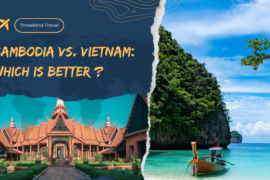
On your next Southeast Asia adventure, where should you go? Cambodia vs. Vietnam? To help you decide, this post compares the best sites in both countries.
Choosing between them with attractions like Angkor Wat and Halong Bay is not easy. We’ll look at the main contrasts in landscapes, cuisine, culture, cities, and weather. Our Cambodia vs. Vietnam guide gives you what to think about when choosing a destination for a tour to Vietnam and Cambodia.
1. Landscapes
Cambodia and Vietnam offer sublime natural scenery, from densely wooded jungles to majestic mountains. Let’s examine their different landscapes:
Cambodia is a very green country. The forests and rice fields spread out in all directions as far as one can see. Winding rivers such as the Mekong and Tonle Sap are lined with tall trees, which make excellent homes for monkeys, waterbirds, and other wildlife. Sights to behold include the emerald mountains of Bokor National Park and unspoiled tropical islands in the Gulf of Thailand. The biodiversity in places like the Cardamom Mountains is also amazing.
From the soaring limestone pillars rising out of the ocean in Halong Bay to the terraced rice paddies of the Sapa uplands, Vietnam’s landscapes are just as impressive. The other features are green that has been cut into the mists of mountains playing a variety of hues. The craggy coastline with sandy beaches and pounding surf draws surfers. Looking inland, dense jungle covers much of the land and antique villages dot the valleys.
Both countries boast stunning natural scenery. Cambodia appeals especially to those in need of a tropical forest and unspoiled feeling. Vietnam boasts the familiar resort scenery of Halong Bay, together with unspoiled rural communities. Stunning scenery whichever destination you choose with your vietnam holiday packages!
2. Cuisine
The food is a highlight in both Cambodia and Vietnam. Their cuisines have similarities but also unique flavors worth exploring.
In Cambodia, rice is central and comes in many forms from thick porridge to thin crepes. Soups feature coconut milk and chili peppers for warmth. Popular dishes include amok curry – fish in creamy coconut curry – and nom piah, crispy rice pancakes. Seasonal tropical fruits like mangoes are a sweet snack. Meals have Chinese and Thai influences but flavors remain milder compared to neighbors.

Vietnamese food excels at balancing textures and temperatures. Soups like pho noodle broth keep you fueled, with beef, meatballs and fresh herbs. Another staple is banh mi baguettes stuffed with pork, pate, and pickles. Crispy spring rolls and soft buns called banh xeo show French touches. Then there’s Vietnamese coffee, sweetened condensed milk cutting the bitter edge. Regions shape specialties like Hanoi’s melt-in-your-mouth bun cha pork patties.
Sample street stalls and markets of both to try flavor-packed snacks like grilled skewers. Cambodia and Vietnam wow foodies, so relax over meals as you explore these diverse cultures. Taste your way through both for an epic eating adventure tour to Vietnam and Cambodia!
3. Culture
The cultures of Cambodia and Vietnam showcase a rich heritage with influences from India, China, and beyond.
In Cambodia, the Khmer Empire left a defining mark. Angkor Wat is one of the most iconic symbols representing their history. Wander the grounds of this massive temple complex and admire bas-reliefs depicting Hindu mythology. Today, most Cambodians follow Theravada Buddhism. See saffron-robed monks in the early morning and strings of white prayer flags outside homes. Traditional arts like silk weaving keep customs alive.
Vietnam merged elements from its northern and southern regions. In the capital, Hanoi, ancestral worship and Confucianism persist. Visit ornate temples and the historic Old Quarter lined by shophouses. Further south, Saigon holds remnants of French influence under its modern gleam. Along the imperial city of Hue are pagodas and tombs of Nguyen Dynasty kings. Like Cambodia, the Vietnamese respect Buddhist, Taoist, and Confucian philosophies in daily life.
Both destinations offer a peek into proud communities shaped by geography, politics, and faith over time. Immerse yourself in the culture by interacting with locals keeping traditions alive today.
4. Cities
Cambodia and Vietnam hold dynamic cities worth exploring for their diversity. Some top spots for tour to Vietnam and Cambodia include:
- Phnom Penh – Cambodia’s capital buzzes with energy amid its leafy boulevards. Must-sees include the glittering Royal Palace and imposing Silver Pagoda. Soak in the lively atmosphere along the Tonle Sap River.

- Siem Reap – Base yourself here near the temples of Angkor, like the towering Angkor Wat. After a day exploring jungle-swathed ruins, dine on gastro delights along Pub Street.

- Hanoi – Vietnam’s cultural heart retains its Old Quarter, a maze of lanes selling silk and street food. Pay respects at Ho Chi Minh Mausoleum and One Pillar Pagoda.
- Ho Chi Minh City – Also called Saigon, this southern boomtown moves to a fast-paced beat. Shop the chaotic Ben Thanh Market and stroll colonial District 1.
- Hoi An – Well-preserved architecture lines the riverside in this lovely Vietnamese town. Wander lantern-lit streets and watch tailors work their magic.
Both countries offer history, nature, and unique experiences within their diverse cities. With memorable food scenes, varied architecture, and welcoming locals, you’ll find plenty to occupy you in holidays to Cambodia and Vietnam’s vibrant urban hubs.
5. Weather
The weather patterns in Cambodia and Vietnam differ slightly due to their locations. Here’s a quick overview:
- Cambodia has a tropical monsoon climate with two main seasons – the wet season from May to October when heavy rains pour, and the dry season from November to April when sunny skies prevail. Temperatures remain warm and humid year-round, around 25-35°C. The wet season sees spectacular lush greenery but some areas become inaccessible.
- Vietnam’s climate also involves tropical monsoons, but the north is cooler from December to February, with occasional cold snaps. Further south stays hot and humid with less rain. Hanoi averages 15-30°C while Ho Chi Minh City stays at 20-35°C. Vietnam’s rainy season coincides with Cambodia’s. Halong Bay shines in fair weather from March to May.

Both countries offer waterfalls and landscapes transformed during wet seasons. Most travelers have Cambodia tour packages from December to April or holiday packages to Vietnam from November to April for mild, dry conditions. But determined explorers enjoy lower prices in the rainy months too. Monsoons necessitate light clothing that dries quickly. With a packed poncho, you can still enjoy outdoor activities in all weather.
6. Final words – Cambodia vs. Vietnam?
In conclusion, Cambodia and Vietnam both offer incredible cultural and natural attractions that will delight any traveler – from iconic temples like Angkor Wat to scenic landscapes like Halong Bay. While choosing between these captivating Southeast Asian countries can be difficult, focusing your trip on one allows for maximum exploration or both if you have a long trip.
For the best way to experience the highlights of Cambodia or Vietnam, let Threeland Travel create a customized tour just for you. Browse our Cambodia tour packages, Vietnam holidays, or combined tour to Vietnam and Cambodia itineraries online today. Our local experts guarantee an immersive trip filled with unforgettable memories. Don’t miss your chance – book with Threeland Travel now!


